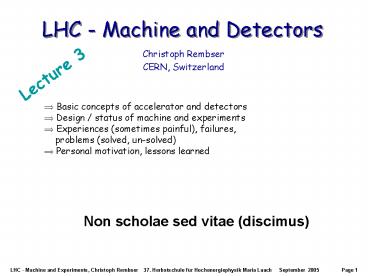LHC Machine and Detectors - PowerPoint PPT Presentation
1 / 27
Title:
LHC Machine and Detectors
Description:
LHC - Machine and Experiments, Christoph Rembser 37. ... Basic concepts of accelerator and detectors. Design / status of machine ... little solder ball ('bump ... – PowerPoint PPT presentation
Number of Views:62
Avg rating:3.0/5.0
Title: LHC Machine and Detectors
1
LHC - Machine and Detectors
- Christoph Rembser
- CERN, Switzerland
Lecture 3
- Basic concepts of accelerator and detectors
- Design / status of machine and experiments
- Experiences (sometimes painful), failures,
- problems (solved, un-solved)
- Personal motivation, lessons learned
Non scholae sed vitae (discimus)
2
Detectors our cameras for new particles
Prediction of the decay mode, signature
in detector and event kinematics
? design of a detector
3
The four players at LHC
4
and where they are
5
What they (we) want to measure?
- which property of a particle we want to measure?
- momentum, charge, kind, energy
from
to
or from
to
6
Detectors (very) brief introduction
- We can not see the particles directly, but
observe their interactions with the detector
material - Mainly electro-magnetic interactions
- (except strong IA ? hadronic showers, weak ?
neutrino detection) - Energy loss interaction of particle with
electrons of atomic shell
7
Energy loss via ionisation
- mean energy loss is described by the Bethe-Bloch
formula, as a function of Q, ß? - ltdE/dxgt ? 1/ß2 Q2 K lnQ2 ln?2
- ß2 - d(ß)
density effects, causing plateau
electron density
classical Rutherford scattering
relativistic rise Lorentz boost
m
ONE function for all particles!!!
1/ß2
Useful for experiments
ln?2- d(ß)
50
ln?2
m.i.p.
???m?p
3...4
8
Particle identification using dE/dx
Nostalgia
Example OPAL large tracking chamber _at_ LEP
at LHC detectors dE/dx measurements not used for
particle identification
but maybe again at an ILC detector?
9
Lorentz force helps
- to distinguish between positiv/negativ charged
particles - to measure the momentum of a charged particle
- but can give bad surprises.
10
Bremsstrahlung
- interaction with the
- Coulomb field of a nucleus
X0 radiation length
muons/iron
electrons/lead
11
Photons in Matter
- intensity of a photon beam is reduced via
- photo effect (photo absorption, ? (A) ? e-
A) - Compton scattering
- pair creation (? A ? e e- A)
?
dominant for high energies pair creation
? damping coefficient
12
A short summary
13
A short summary
e e-
K- decay
K-
p -
d-Electrons
µ-
e-
here no individual Clusters, high dE/dx, lowß?
14
Transition radiation
- charged particle crosses the boundary between 2
materials with different dielectrical constants - I ? ? particle identification between 1 - few
100GeV - emitted energy ?1-?2
- number of radiated photons (E1-20keV) ??
for efficient detector many boundaries (
O100) polypropylen, CO2 Theory Ginzburg, Frank
1946
Lilienfeld 1919 Es ist Dunkeladaption des Auges
notwendig um einen Elektronenstrahl mit 5keV
Energie und 20 µA Strahlstrom wahrzunehmen
Physikalische Zeitschrift 1919 20, 280
15
A short word on neutrinos
only true for experiments at accelerators
16
Large scale experiments
ALEPH EXP at LEP 1980 first meetings 1982
Experiment Approved 1989 First Collisions 2000
Last run gt2005 Last publication
CMS EXP at LHC 1991 first meetings 1994
Experiment Approved 2007 First Collisions 2010
Design Luminosity gt2014 Luminosity upgrade
17
Detector components
- particle tracking
- energy measurement
- particle identification
good for collider fix target experiments, neutri
no experiments less components
18
Reminder a general purpose collider detector
- hermetic
- tracking detectors
- light materials
- magnetic field in
- tracker
- calorimeters very
- dense materials
- enclosed by muon
- system
- particle ID
- (Cherenkov, time-of-flight)
19
Requirements for the tracking detectors
- E.g. search for
- H?Z0Z0???-??-
- with ?mZ lt 2GeV
- up to pz 500GeV
- reconstruction of
- high pt tracks with
- high efficiency
- single track ? gt 95
- in jet ? gt 90
- momentum resolution
- ?pt/pt 0.01 pt GeV
20
Momentum resolution
e.g. 12 layers of silicon (CMS) with a didgital
resolution (d/v12) give a momentum resolution of
1 TeV track sagitta180µm
track
pt too low
21
Silicon strip detector
- p-n junction diode operated at reverse bias (no
charges in n-bulk ? depletion voltage) - traversing charged particle creates charges which
drift to readout strips ? induce signal - no e- multiplication, signal dE/dx (thickness
of material), 2200 e/hole pairs for 300µm
22
Better resolution charge division
- from measured pulse heights, centre-of-gravity is
calculated ?PHL/(PHLPHR) - typical resolutions for silicon strips 10-20 µm
- strips measure 1 coordinate only ? need two
orthogonal layers or
23
Pixel detectors
connection between detector and readout chip
little solder ball (bump bonding)
24
The CMS Tracker
Pixel
End cap TEC-
Outer Barrel TOB-
Inner Barrel TIB-
Inner Disks TID-
2,4 m
5.4 m
Support tube
25
Enormous amount of Si!
ALEPH
CMS
26
Surprises happen (CDF, NA60)
- During test pulse operation, Lorentz force on
bonding wires (perpendicular to magnetic field)
breakes wire bonds between detector and read out.
Detectors expect the unexpected!
27
Recent developements
Silicon drift detector, ALICE
much cheaper!































